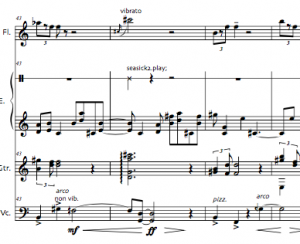Mountain Piques was written for the Pique Collective, a Baltimore-based new music ensemble. Split into four movements, this work uses electronics to create four nature-inspired scenes. It was performed in October 2018 at the Black Cherry Puppet Theatre, who created and choreographed visuals to accompany the piece.
This piece uses SuperCollider to produce the electronic part. A member of the quartet operates a laptop which activates prerecorded audio samples. They use their laptop keyboard trackpad to change the pitch and volume of the samples. This allowing them to, like an acoustic instrument, interact with ensemble and interpret it a little differently for each performance. Graphic notation describes how the electronic musician should perform on the laptop.
 The ensemble writing is intricate and tightly woven, and takes a neoclassical approach to form. I tried to give equal importance to rhythm, melody, sound, harmony, and gesture. Though many parts sound tonal, the work was too chromatic for me to set to a specific key. Much of the piece’s complexity is derived from heavy ornamentation. The most rhythmic movement, Bursting at the Brim, features a twelve-tone polyrhythm juxtaposed with a tonal theme played by the guitar.
The ensemble writing is intricate and tightly woven, and takes a neoclassical approach to form. I tried to give equal importance to rhythm, melody, sound, harmony, and gesture. Though many parts sound tonal, the work was too chromatic for me to set to a specific key. Much of the piece’s complexity is derived from heavy ornamentation. The most rhythmic movement, Bursting at the Brim, features a twelve-tone polyrhythm juxtaposed with a tonal theme played by the guitar.
The piece’s entirety can be listened to here:

 r, I had a performable draft. After winning third prize in Peabody’s Prix d’Eté, the final movement Gravity was programmed in the Peabody Thursday Noon Concert Series, with
r, I had a performable draft. After winning third prize in Peabody’s Prix d’Eté, the final movement Gravity was programmed in the Peabody Thursday Noon Concert Series, with 